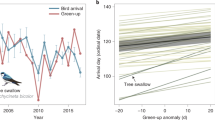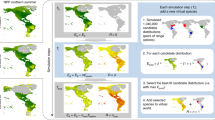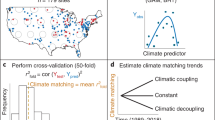Abstract
Climate change induced phenological shifts in primary productivity result in trophic mismatches for many organisms1,2,3,4, with broad implications for ecosystem structure and function. For birds that have a synchronized timing of migration with resource availability, the likelihood that trophic mismatches may generate a phenological response in migration timing increases with climate change5. Despite the importance of a holistic understanding of such systems at large spatial and temporal scales, particularly given a rapidly changing climate, analyses are few, primarily because of limitations in the access to appropriate data. Here we use 24 years of remotely sensed data collected by weather surveillance radar to quantify the response of a nocturnal avian migration system within the contiguous United States to changes in temperature. The average peak migration timing advanced in spring and autumn, and these changes were generally more rapid at higher latitudes. During spring and autumn, warmer seasons were predictive of earlier peak migration dates. Decadal changes in surface temperatures predicted spring changes in migratory timing, with greater warming related to earlier arrivals. This study represents one of the first system-wide examinations during two seasons and comprises measures from hundreds of species that describe migratory timing across a continent. Our findings provide evidence of spatially dynamic phenological shifts that result from climate change.
This is a preview of subscription content, access via your institution
Access options
Access Nature and 54 other Nature Portfolio journals
Get Nature+, our best-value online-access subscription
$29.99 / 30 days
cancel any time
Subscribe to this journal
Receive 12 print issues and online access
$209.00 per year
only $17.42 per issue
Buy this article
- Purchase on Springer Link
- Instant access to full article PDF
Prices may be subject to local taxes which are calculated during checkout




Similar content being viewed by others
Data availability
The datasets generated during and/or analysed during the current study are available at https://doi.org/10.6084/m9.figshare.10062239.v1.
Code availability
Radar processing code and algorithms can be found at https://zenodo.org/record/3352264#.XXesby2ZPRY
References
Thackeray, S. J. et al. Phenological sensitivity to climate across taxa and trophic levels. Nature 535, 241–245 (2016).
Parmesan, C. & Yohe, G. A globally coherent fingerprint of climate change impacts across natural systems. Nature 421, 37–42 (2003).
Walther, G.-R. et al. Ecological responses to recent climate change. Nature 416, 389–395 (2002).
Cohen, J. M., Lajeunesse, M. J. & Rohr, J. R. A global synthesis of animal phenological responses to climate change. Nat. Clim. Change 8, 224–228 (2018).
Both, C. & Visser, M. E. Adjustment to climate change is constrained by arrival date in a long-distance migrant bird. Nature 411, 296–298 (2001).
Parmesan, C. Ecological and evolutionary responses to recent climate change. Annu. Rev. Ecol. Evol. Syst. 37, 637–669 (2006).
Cleland, E. E., Chuine, I., Menzel, A., Mooney, H. A. & Schwartz, M. D. Shifting plant phenology in response to global change. Trends Ecol. Evol. 22, 357–365 (2007).
Saino, N. et al. Climate warming, ecological mismatch at arrival and population decline in migratory birds. Proc. R. Soc. B 278, 835–842 (2011).
Jones, T. & Cresswell, W. The phenology mismatch hypothesis: are declines of migrant birds linked to uneven global climate change? J. Anim. Ecol. 79, 98–108 (2010).
Hoffmann, A. A. & Sgrò, C. M. Climate change and evolutionary adaptation. Nature 470, 479–485 (2011).
Chmura, H. E. et al. The mechanisms of phenology: the patterns and processes of phenological shifts. Ecol. Monogr. 89, e01337 (2019).
Berthold, P. Control of Bird Migration (Chapman and Hall, 1996).
Both, C., Bouwhuis, S., Lessells, C. M. & Visser, M. E. Climate change and population declines in a long-distance migratory bird. Nature 441, 81–83 (2006).
Butler, C. J. The disproportionate effect of global warming on the arrival dates of short-distance migratory birds in North America. Ibis 145, 484–495 (2003).
Møller, A. P., Rubolini, D. & Lehikoinen, E. Populations of migratory bird species that did not show a phenological response to climate change are declining. Proc. Natl Acad. Sci. USA 105, 16195–16200 (2008).
Kelly, J. F. & Horton, K. G. Toward a predictive macrosystems framework for migration ecology. Glob. Ecol. Biogeogr. 25, 1159–1165 (2016).
Mayor, S. J. et al. Increasing phenological asynchrony between spring green-up and arrival of migratory birds. Sci. Rep. 7, 1–10 (2017).
Jonzén, N. et al. Rapid advance of spring arrival dates in long-distance migratory birds. Science 312, 1959–1961 (2006).
Balbontín, J. et al. Individual responses in spring arrival date to ecological conditions during winter and migration in a migratory bird. J. Anim. Ecol. 78, 981–989 (2009).
Pettorelli, N. et al. Using the satellite-derived NDVI to assess ecological responses to environmental change. Trends Ecol. Evol. 20, 503–510 (2005).
Horton, K. G. et al. Holding steady: little change in intensity or timing of bird migration over the Gulf of Mexico. Glob. Change Biol. 25, 1106–1118 (2019).
Lin, T. et al. MISTNET: Measuring historical bird migration in the US using archived weather radar data and convolutional neural networks. Methods Ecol. Evol. 10, 1908–1922 (2019).
La Sorte, F. A. et al. The role of atmospheric conditions in the seasonal dynamics of North American migration flyways. J. Biogeogr. 41, 1685–1696 (2014).
Marra, P. P., Francis, C. M., Mulvihill, R. S. & Moore, F. R. The influence of climate on the timing and rate of spring bird migration. Oecologia 142, 307–315 (2005).
Post, E., Steinman, B. A. & Mann, M. E. Acceleration of phenological advance and warming with latitude over the past century. Sci. Rep. 8, 3927 (2018).
Bauer, S. et al. The grand challenges of migration ecology that radar aeroecology can help answer. Ecography 42, 861–875 (2019).
Winger, B. M., Auteri, G. G., Pegan, T. M. & Weeks, B. C. A long winter for the Red Queen: rethinking the evolution of seasonal migration. Biol. Rev. 94, 737–752 (2019).
Miller, R. A., Carlisle, J. D., Paprocki, N., Kaltenecker, G. S. & Heath, J. A. in Phenological Synchrony and Bird Migration: Changing Climate and Seasonal Resources in North America Vol. 47 (eds Wood, E. M. & Kellermann, J. L.) 177–191 (CRC, 2015).
Jarjour, C., Frei, B. & Elliott, K. H. Associations between sex, age and species-specific climate sensitivity in migration. Anim. Migr. 4, 23–36 (2017).
Lameris, T. K. et al. Arctic geese tune migration to a warming climate but still suffer from a phenological mismatch. Curr. Biol. 28, 2467–2473.e4 (2018).
Rakhimberdiev, E. et al. Fuelling conditions at staging sites can mitigate Arctic warming effects in a migratory bird. Nat. Commun. 9, 1–10 (2018).
Carlisle, J. D. et al. Landbird migration in the American West: recent progress and future research directions. Condor 111, 211–225 (2009).
Gill, J. A. et al. Why is timing of bird migration advancing when individuals are not? Proc. R. Soc. B 281, 20132161 (2014).
Horton, K. G. et al. Bright lights in the big cities: migratory birds’ exposure to artificial light. Front. Ecol. Environ. 17, 209–214 (2019).
Crum, T. D., Alberty, R. L. & Burgess, D. W. Recording, archiving, and using WSR-88D data. Bull. Am. Meteorol. Soc. 74, 645–653 (1993).
Rosenberg, K. V. et al. Decline of the North American avifauna. Science 366, 120–124 (2019).
Richardson, W. J. Timing and amount of bird migration in relation to weather: a review. Oikos 30, 224–272 (1978).
Richardson, W. J. in Bird Migration (ed. Gwinner, E.) 78–101 (Springer, 1990).
Long, J., Darrell, T. & Shelhamer, E. Fully convolutional networks for semantic segmentation. In 2015 IEEE Conference on Computer Vision and Pattern Recognition (CVPR) 3431–3440 (IEEE, 2015).
Simonyan, K. & Zisserman, A. Very deep convolutional networks for large-scale image recognition. Preprint at https://arxiv.org/abs/1409.1556 (2015).
Rumelhart, D. E., Hinton, G. E. & Williams, R. J. Learning representations by back-propagating errors. Nature 323, 533–536 (1986).
Goodfellow, I., Bengio, Y. & Courville, A. Deep Learning (MIT, 2016).
Farnsworth, A. et al. A characterization of autumn nocturnal migration detected by weather surveillance radars in the northeastern US. Ecol. Appl. 26, 752–770 (2016).
Browning, K. A. & Wexler, R. The determination of kinematic properties of a wind field using Doppler radar. J. Appl. Meteor. 7, 105–113 (1968).
Buler, J. J. & Diehl, R. H. Quantifying bird density during migratory stopover using weather surveillance radar. IEEE Trans. Geosci. Remote Sens. 47, 2741–2751 (2009).
Horton, K. G., Van Doren, B. M., Stepanian, P. M., Farnsworth, A. & Kelly, J. F. Where in the air? Aerial habitat use of nocturnally migrating birds. Biol. Lett. 12, 20160591 (2016).
Sheldon, D. et al. Approximate Bayesian inference for reconstructing velocities of migrating birds from weather radar. In Proceedings of the Twenty-Seventh AAAI Conference on Artificial Intelligence 1334–1340 (AAAI, 2013).
Sheldon, D. WSRLIB: MATLAB Toolbox for Weather Surveillance Radar (Bitbucket, 2015); https://bitbucket.org/dsheldon/wsrlib
Dokter, A. M. et al. Bird migration flight altitudes studied by a network of operational weather radars. J. R. Soc. Interface 8, 30–43 (2011).
Horton, K. G., Van Doren, B. M., Stepanian, P. M., Farnsworth, A. & Kelly, J. F. Seasonal differences in landbird migration strategies. Auk 133, 761–769 (2016).
Chilson, P. B. et al. Estimating animal densities in the aerosphere using weather radar: to Z or not to Z? Ecosphere 3, art72 (2012).
Sullivan, B. L. et al. The eBird enterprise: an integrated approach to development and application of citizen science. Biol. Conserv. 169, 31–40 (2014).
Wood, S. mgcv: mixed GAM computation vehicle with GCV/AIC/REML smoothness estimation. R package version 1.8-28 (2015).
Mesinger, F. et al. North American regional reanalysis. Bull. Am. Meteorol. Soc. 87, 343–360 (2006).
Acknowledgements
NSF Advances in Biological Informatics (ABI-1661259), Division of Information and Intelligent Systems (IIS-1633206) and Integrative and Collaborative Education and Research (1927743) programmes, as well as a Leon Levy Foundation and an Edward W. Rose Postdoctoral Fellowship supported this research.
Author information
Authors and Affiliations
Contributions
All the authors worked to conceive and design this study. K.G.H., F.A.L., D.S. and A.F. drafted the manuscript. T.-Y.L., K.W., G.B., S.M., K.G.H. and D.S. designed the radar algorithms, and processed and summarized the radar data. K.G.H. generated the figures and D.S., W.M.H. and K.G.H. designed the analyses. All the authors provided editorial advice, approved the final version of this manuscript and are in agreement to be accountable for all aspects of the work.
Corresponding author
Ethics declarations
Competing interests
The authors declare no competing interests.
Additional information
Publisher’s note Springer Nature remains neutral with regard to jurisdictional claims in published maps and institutional affiliations.
Rights and permissions
About this article
Cite this article
Horton, K.G., La Sorte, F.A., Sheldon, D. et al. Phenology of nocturnal avian migration has shifted at the continental scale. Nat. Clim. Chang. 10, 63–68 (2020). https://doi.org/10.1038/s41558-019-0648-9
Received:
Accepted:
Published:
Issue Date:
DOI: https://doi.org/10.1038/s41558-019-0648-9
This article is cited by
-
Avian migration clocks in a changing world
Journal of Comparative Physiology A (2024)
-
Inconsistent shifts in warming and temperature variability are linked to reduced avian fitness
Nature Communications (2023)
-
Spring phenology is advancing at a faster rate than arrival times of Common Starling
Journal of Ornithology (2023)
-
The role of semiannual cycle in modulating seasonality changes of surface air temperature over China and its mechanism
Climate Dynamics (2023)
-
Global warming leads to larger bats with a faster life history pace in the long-lived Bechstein’s bat (Myotis bechsteinii)
Communications Biology (2022)



